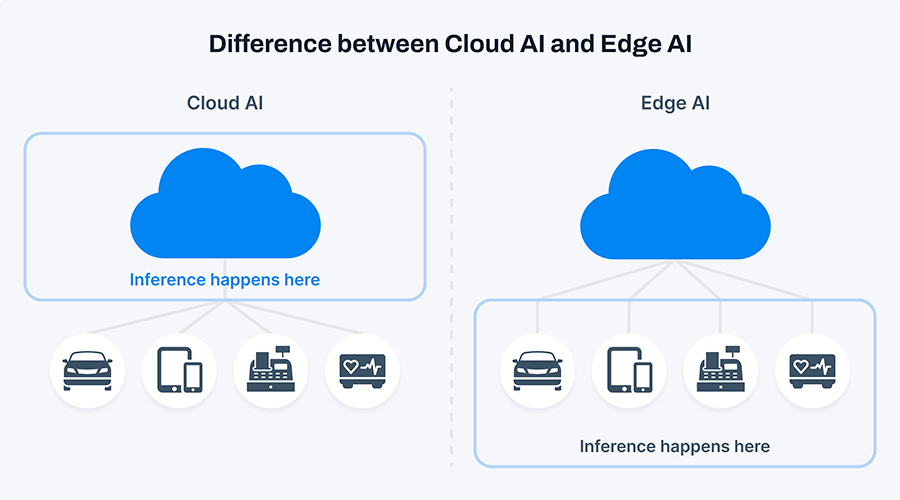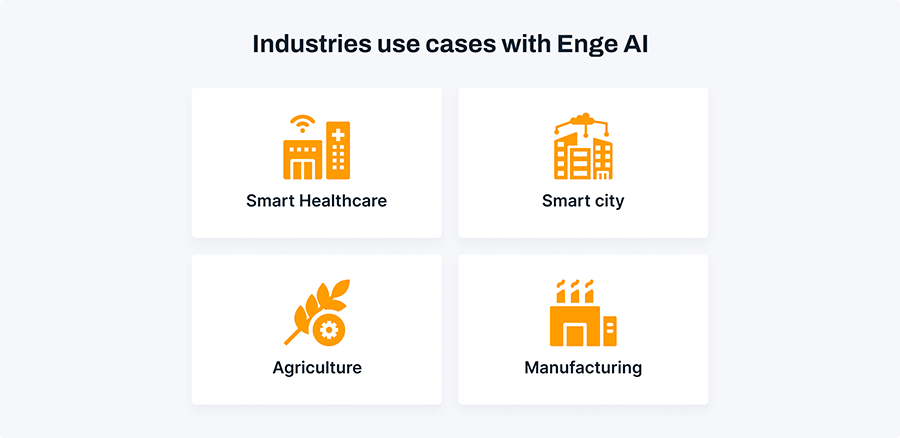Beyond the Cloud: How Edge AI Optimizes IoT Data Processing
April 04, 2024Edge AI is the application of AI algorithms and models immediately to edge devices, like sensors, cameras, phones, or IoT devices, bypassing the cloud-based central servers for data processing. This method consists of data processing on a local basis and pushing the results to the edge of the network without transmitting data to a remote server.
Edge AI incorporates the computational ability of the edge devices for various works, data preprocessing, real-time analytics, decision-making, and even machine learning inference resulting in less delay and necessary data usage and reducing dependence on cloud services.
This article delves into edge AI in IoT, its use cases, benefits, and the potential for shaping the IoT systems industry.
4 Key differences between edge AI vs. cloud AI
Cloud providers and APIs are used for training and deploying machine learning models, unlike edge AI, which shows predictive analytics and speech recognition for anomaly detection near the user, closer to the data source. This feature sets it apart from traditional cloud-based ones. Edge AI systems work thus - they process and analyze data from the very place where it's created, compared to the cloud alone. The machine learning algorithms work on IoT devices, bypassing the need for a central server or data center.
Cloud AI is a fusion of cloud computing and artificial intelligence technologies that offers advanced solutions for organizations. It enables businesses to leverage AI to compete effectively, solve problems, and meet market demands. AI Clouds provide technology across the AI lifecycle, including developing features, models, and applications, operating and monitoring them, and sharing them across the organization. AI in cloud computing automates tasks, streamlines data management, enhances information security and facilitates data transfers between on-premise and cloud environments.

1. Latency
Edge AI offers low latency as data processing occurs locally, enabling real-time decision-making.
Cloud AI may experience higher latency due to data transfers to and from remote servers, impacting real-time responsiveness.
2. Bandwidth
Edge AI requires minimal bandwidth as data processing is performed locally, reducing the need for extensive data transfer.
Cloud AI relies on substantial bandwidth for data transmission to and from remote servers, potentially leading to higher network congestion.
3. Privacy and security
Edge AI enhances data privacy and security as sensitive information remains on the device or within the local network, reducing exposure to external threats.
Cloud AI raises concerns about data privacy and security due to data transmission over public networks and storage on remote servers, necessitating robust security measures.
4. Cost
Edge AI may involve higher upfront costs for device hardware and software development but can result in lower operational costs over time, especially for applications with low data transfer requirements.
Cloud AI typically incurs ongoing costs for cloud service usage, including data storage, processing, and network bandwidth, which can vary based on usage patterns and resource allocation.
Edge AI is particularly efficient in situations that require instant decisions or limited connectivity, while Cloud AI is more suitable for processing large amounts of data effectively. The final choice will depend on the specific use case, connectivity availability, scalability requirements, and data sensitivity considerations.
Edge AI industry use cases

Smart cities
Smart cities apply sophisticated technologies to develop solutions aimed at curbing the intractable problems seen in urban areas. IoT devices with Edge AI enhance multiple spheres of urban life to achieve these solutions.
The main feature that makes smart cities different is intelligent infrastructure management. The city's decision-makers can collect crucial real-time data from sensors and monitoring systems, such as traffic recedes, energy usage, and garbage handling. This data helps them optimize resource allocations, clear up congestion, and minimize environmental impacts.
Using IoT sensors and AI algorithms, cities can measure air and water quality to inform communities of potential environmental dangers and take the right measures to reduce pollution.
Healthcare
Edge AI is the main reason why patient care and medical service provisioning are now carried out revolutionary. Harnessing edge computing in AI provides a way to perform processing power on the AI algorithms at scale employing the data generated by the IoT devices, wearables, and medical sensors in real-time. They can carry out quicker and more accurate diagnoses by using data on the prediction of the patient outcome and making personal treatment plans by using individual patient data as well.
One of the main reasons why edge AI is important in healthcare is that it can process sensitive private data directly on a device without sending it to a remote/off-site server. It contributes to the data privacy and security that are needed to fix patient confidentiality and regulatory queries.
Manufacturing
With edge AI adoption across the globe, manufacturing industries are removing barriers and accelerating their business processes. With the help of sensors and data, they could even go as far as predictive maintenance on any equipment, identifying abnormalities and potential breakdowns before they happen. This preventative approach is a way to minimize downtime and make things work the way they should.
Implementing in many production areas, particularly in quality employee control protection in supply chain analytics and floor optimization. It ensures real-time discovery and optimization for the production process, therefore high efficiency is maintained throughout the whole production line with continuous improvement.
Agriculture
Remote AI is transforming agriculture by allowing online decision-making and monitoring of the fields in real-time. Regardless of cloud connectivity, farmers can now use AI technology deployed on edge devices like drones, sensors, or farm equipment to analyze field data directly. This ensures unprecedented timeliness of disease identification in crop production, pest attacks, soil moisture, and other critical factors that may affect crop health and yield.
On top of that, Edge AI expands farming automation by allowing autonomous vehicles and robotic systems to move purposefully as well as perform tasks on the spot. Activity encompasses seeding, harvesting, and weeding, which helps in improving productivity and cutting labor costs.
Connection between Edge AI and IoT
The connection between Edge AI and IoT is a powerful synergy that revolutionizes data processing and decision-making capabilities in the IoT structure. Edge AI involves algorithms locally on hardware devices, processing data near its source instead of transmitting it to centralized servers. This integration offers numerous benefits that go beyond low-latency data processing, like increased speed and improved privacy and security.
The convergence of Edge AI and IoT creates a new paradigm, the artificial intelligence of Things (AIoT), offering real-time data processing, enhanced decision-making capabilities, and operational efficiency across various industries. This technological symbiosis enables applications like real-time defect detection in manufacturing, remote patient monitoring in healthcare, equipment monitoring in energy sectors, self-driving vehicles in transportation, security event detection in retail, surveillance in smart cities, and more.
Edge AI algorithms used in IoT devices
Edge AI algorithms used in IoT devices cover a wide range of applications and functionalities, tailored to specific use cases and requirements.
1. Anomaly detection
Algorithms are designed to identify abnormal patterns or deviations from expected behavior in sensor data streams. These algorithms help detect anomalies in various systems, such as industrial machinery, HVAC systems, or network traffic.
2. Object recognition
Capability of recognizing and identifying objects or patterns in images or video streams captured by IoT cameras or sensors. These algorithms are used for applications such as surveillance, smart retail, and industrial automation.
3. Natural language processing (NLP)
Algorithms enable IoT devices to understand and process human language, allowing for voice-controlled interfaces and intelligent assistants. NLP algorithms can perform speech recognition, language translation, and sentiment analysis.
4. Reinforcement learning
Algorithms that enable IoT devices to learn and adapt to their environment through trial and error, optimizing their behavior to achieve specific goals. Reinforcement learning algorithms are used in applications such as autonomous vehicles, robotics, and smart grid optimization.
Edge AI in the security of IoT devices
Edge AI significantly enhances the security of IoT devices by processing data locally on the edge devices themselves, reducing the need to transmit sensitive information to external servers. The key ways in which Edge AI improves IoT device security are:
1. Reduced data exposure
Processing data locally with Edge AI minimizes the amount of data sent over networks, reducing exposure to potential cyber-attacks and data breaches.
2. Enhanced privacy
By keeping sensitive information on the device through local processing, Edge AI improves privacy and reduces the risk of unauthorized access to personal data.
3. Mitigated cybersecurity risks
Minimizing data transmission and processing critical information locally helps mitigate cybersecurity risks associated with cloud-based processing and communication.
4. Improved reliability
The decentralized nature of Edge AI enhances system reliability by reducing dependency on cloud connectivity, ensuring continuous operation even in cases of network disruptions.
Conclusion
Edge AI is changing the face of the IoT devices industry by empowering the devices with the capabilities of real-time data processing, data analytics, and decision-making directly at the edge of the networks. IoT devices will now be able to perform complex tasks autonomously through Edge AI to increase efficiency and security, furthermore, new applications and services across different sectors will emerge. The evolution of Edge AI towards its integration with IoT devices will foster novel ways of employing the technology, change the way companies operate, and herald in a more intelligent and interconnected world. The partnership between Edge AI and IoT is poised to bring about revolutionary change, improve user experiences, and open up new frontiers for expansion and development in the digital industry.
FAQ
Does Edge have an AI tool?
Edge AI has a tool called Edge AI Studio, which is a collection of tools enabling the development, benchmarking, and deployment of AI applications on edge devices like IoT devices. It includes features like Model Composer, Model Analyzer, and Model Maker.
What is the difference between IoT and edge AI?
The key difference between IoT and Edge AI lies in data processing location. IoT devices connect to the cloud for processing, while edge AI devices perform computations locally.
How do I get AI on Edge?
To get AI on Edge, you can utilize software development kits (SDKs) provided by AI companies or develop custom solutions tailored to your specific edge device and application requirements.
How do I combine AI and IoT?
To combine AI and IoT, integrate AI algorithms into IoT devices or cloud platforms to process and analyze data locally, enabling real-time insights and decision-making.
Where we cannot use Edge AI?
Edge AI may not be suitable for tasks requiring extensive computational power or large datasets, such as complex deep learning models or data-intensive processing, better suited for cloud-based solutions.


